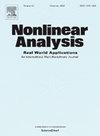包含时间延迟的年龄结构捕食者-猎物模型的持续振荡
IF 1.8
3区 数学
Q1 MATHEMATICS, APPLIED
引用次数: 0
摘要
近年来对理论生态学中捕食者-猎物模型的研究发现,它们之间的相互作用不仅受到捕食者-猎物反应时间延迟τ1的限制,而且还受到捕食者发育时间τ2的控制。在此基础上,探讨和分析了双时滞对捕食者-猎物模型的影响。在生物环境复杂性的影响下,采用一种新的比率依赖的功能反应来反映食饵和捕食者之间的关系。我们研究了系统的平衡状态和线性化方程,并结合了正平衡状态的特征方程和边界平衡的全局稳定性。此外,我们的数学分析表明,当参数τ1和τ2独立变化时,系统在正平衡状态下表现出稳定的切换曲线和Hopf分岔。在τ1=τ2的情况下,也存在持续的周期振荡。最后,用详细的数值模拟对理论结果进行了验证,并进行了简单的总结。本文章由计算机程序翻译,如有差异,请以英文原文为准。
Sustained oscillations in an age-structured predator–prey model incorporating time delay
Recent studies of the predator–prey model in theoretical ecology have found that their interactions are not only limited by the predator–prey reaction time delay but also controlled by the predator development time . Based on this fact, we explore and analyze the effect of double time delays on the predator–prey model. Under the influence of the complexity of the biological environment, a new ratio-dependent functional response is used to reflect the relationship between prey and predator. We explore the equilibrium state and linearized equations of the system, incorporating the characteristic equations of positive equilibrium state and the global stability of boundary equilibrium. Moreover, our mathematical analyses show that when the parameters and are changed independently, the system exhibits the stable switching curves and Hopf bifurcation at the positive equilibrium state. In the case of , there are also sustained periodic oscillations. Ultimately, detail numerical simulations are used to verify the theoretical results and a simple summary is presented.
求助全文
通过发布文献求助,成功后即可免费获取论文全文。
去求助
来源期刊
CiteScore
3.80
自引率
5.00%
发文量
176
审稿时长
59 days
期刊介绍:
Nonlinear Analysis: Real World Applications welcomes all research articles of the highest quality with special emphasis on applying techniques of nonlinear analysis to model and to treat nonlinear phenomena with which nature confronts us. Coverage of applications includes any branch of science and technology such as solid and fluid mechanics, material science, mathematical biology and chemistry, control theory, and inverse problems.
The aim of Nonlinear Analysis: Real World Applications is to publish articles which are predominantly devoted to employing methods and techniques from analysis, including partial differential equations, functional analysis, dynamical systems and evolution equations, calculus of variations, and bifurcations theory.

 求助内容:
求助内容: 应助结果提醒方式:
应助结果提醒方式:


